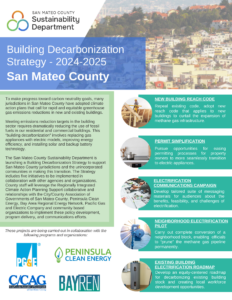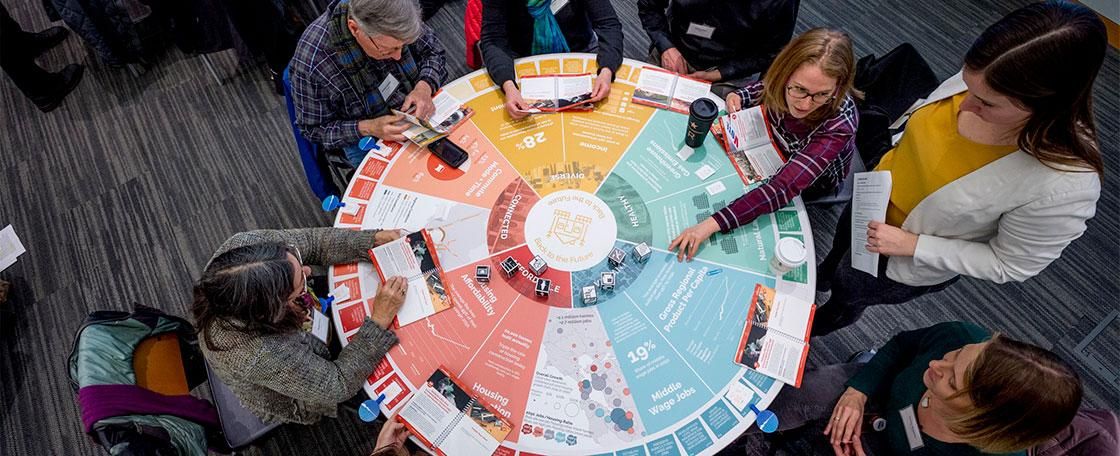Energy Resources for Public Agencies
The San Mateo County Sustainability Department provides numerous support programs for Public Agencies through the San Mateo County Energy Watch (SMCEW) and the Regionally Integrated Climate Action Planning Support (RICAPS) group.
In addition to these programmatic offerings below, the Sustainability Department has launched a Countywide Building Decarbonization Strategy, which features five supporting initiatives. This strategy is intended to advance and accelerate new and existing building electrification and decarbonization policies and programming both in unincorporated San Mateo County and across our 20 local jurisdictions.

San Mateo County Energy Watch
The San Mateo County Energy Watch (SMCEW) is a local government partnership between PG&E and the City/County Association of Governments of San Mateo County (C/CAG), and is administered by the San Mateo County Sustainability Department. SMCEW assists local governments, K-12 public schools, and small businesses in accessing energy efficiency and decarbonization programs and financing opportunities to support energy efficiency and decarbonization projects. SMCEW provides coordination, referrals to programs, outreach, and educational resources.
Resources for Municipalities and Special Districts
Here are some of the resources available for Municipalities and Special Districts. If you have any questions, please reach out to us at energy@smcgov.org
If your organization is interested in pursuing energy efficiency or decarbonization projects, we can help! Our no-cost services include energy audits and reports, help identifying projects, support with bid selection, and assistance with implementation. Our team can also connect finance staff with financing options and other relevant programs.
To help pay for energy efficiency upgrades to local government facilities, PG&E offers 0% interest On-Bill Financing for projects over $5,000. If you are interested in learning more, please contact your PG&E representative or the SMCEW team.
For additional financing resources, the U.S. Department of Energy offers a simple tool for finding financing for energy efficiency and renewable energy projects through the Better Buildings Initiative. The tool allows project managers to input project information and requirements and will connect them with the most ideal type of available financing and finance providers. Check out more using the Better Buildings Financial Navigator.
We can also support local governments in their energy efficiency planning with benchmarking services using Energy Star Portfolio Manager. This service is free to you. and will give you a broad analysis of your energy use over the past twelve months and a list of recommended action items to save energy.
Need to figure out how to convert natural gas equipment in your facilities to all-electric? We can help! During a visit to your facilities, we will help you create an inventory of existing natural gas (methane) powered appliances. (If you’d prefer, we can show you how to use this Excel-based tool so you can complete a catalog on your own.
This tool generates a report that indicates where methane gas is used in facilities, prioritizes equipment for replacement, estimates the cost of replacement, and estimates GHG emissions reductions once all-electric equipment is installed.
You’re invited to join other facilities staff from across the county to learn about decarbonization strategies from your peers and hear industry leaders share insights about a wide array of energy topics.
The Public Sector Facilities Working Group meets quarterly to promote collaboration Participants work with industry professionals and program managers on energy management strategies. They also learn about financial incentives and training opportunities that will help them reduce energy consumption and costs at their facilities.
Resources for K-12 Public Schools
Here are some of the resources available for K-12 Public Schools If you have any questions, please reach out to us at energy@smcgov.org
Join the 42 public schools that are participating in the Green Facilities Data Collection project. The data collected in this project will help identify where key opportunities to improve school facility operations exist, paving the way for healthier and more energy efficient schools that provide a better learning environment for students.
The average age of the main instructional building among reporting U.S. public schools is 49 years, with 38 percent constructed before 1970, according to the National Center for Education Statistics. In order to learn more about school facilities in San Mateo County, the Energy Watch program has partnered with the Office of Education to survey schools and conduct site visits focused on building operations.
Commercial facilities with more than 50,000 square feet of gross floor area area are required to report Energy Star Portfolio Manager building energy benchmarking data to the California Energy Commission annually on June 1st.
Our team can support local public agencies in completing this state requirement at no cost to the agency and will result in a broad analysis of your energy use over the past twelve months and a list of recommended action items for energy efficiency planning.
Contact energy@smcgov.org to learn more and get started with building energy benchmarking.
We can help your school district take advantage of PG&E’s Government & K-12 Schools (GK12) Energy Efficiency Program to improve the energy efficiency of your buildings while reducing ongoing operational and maintenance costs. The GK12 team guides districts through each project step to ensure a smooth experience from enrollment to installation.
If your organization is interested in pursuing energy efficiency or decarbonization projects, we can help! Our no-cost services include energy audits and reports, help identifying projects, support with bid selection, and assistance with implementation. Our team can also connect finance staff with financing options and other relevant programs.
To help pay for energy efficiency upgrades to local government facilities, PG&E offers 0% interest On-Bill Financing for projects over $5,000. If you are interested in learning more, please contact your PG&E representative or the SMCEW team.
For additional financing resources, the U.S. Department of Energy offers a simple tool for finding financing for energy efficiency and renewable energy projects through the Better Buildings Initiative. The tool allows project managers to input project information and requirements and will connect them with the most ideal type of available financing and finance providers. Check out more using the Better Buildings Financial Navigator.
COUNTYWIDE CLIMATE COLLABORATIVE: REGIONALLY INTEGRATED CLIMATE ACTION PLANNING SUPPORT (RICAPS)
The Regionally Integrated Climate Action Planning Support program (RICAPS) serves the 21 local jurisdictions in developing and implementing climate action plans to reduce greenhouse gas emissions countywide and meet countywide GHG reduction goals. The program provides a set of tools and a collaborative space for all 20 incorporated cities and the County to advance climate action planning and implementation. The program offers a comprehensive suite of tools for any city to create or update a climate action plan. These tools include: a climate action plan template (recently updated for 2030 goals), a menu of measures, and a forecasting tool. Cities in San Mateo County can also access technical assistance in utilizing these tools, provided by Rincon Consultants, Inc.
In addition, program staff host monthly working group meetings for program participants to collaborate, exchange ideas, and troubleshoot.
- Join monthly meetings and receive announcements: please contact energy@smcgov.org to join.
- Past presentations: Please follow this link for past RICAPS presentation slide decks
The RICAPS program provides access to a climate action plan template document that the 20 cities in San Mateo County and others can use to save staff time and resources. The template includes: guidance for collaborating with community groups when developing and implementing the CAP, identification of emissions from consumption activities (such as air travel, food, and purchases), and information about carbon sequestration and workforce development. With colorful photos, icons, and informative call-out boxes, the document is designed to be accessible to the public. Since it is formatted in Microsoft Word, city staff can edit it to include their own goals and strategies. The document was prepared in collaboration with an ad hoc advisory group of sustainability coordinators from seven San Mateo County cities, with technical support from Rincon Consultants, Inc.
This document undergoes frequent revision. Please email Avana Andrade at aandrade@smcgov.org for the most recent version.
This Excel-based tool documents the calculations associated with the menu of climate action measures for RICAPS. This Menu of Measures provides a pre-set list of greenhouse gas reduction measures most applicable to the San Mateo County region and a recommended approach to estimating potential greenhouse gas (GHG) emissions avoided from each measure. It was prepared by Rincon Consultants, Inc.
This document undergoes frequent revision. Please email Avana Andrade at aandrade@smcgov.org for the most recent version.
This Excel workbook provides assistance to estimate the business-as-usual greenhouse gas emissions through 2020, 2030, 2040, 2045, and 2050. It assists jurisdictions in calculating the metric tons of greenhouse gasses reduced by California statewide measures and the city-specific measures selected in the RICAPS Menu of Measures Tool, and analyzes whether the reduction targets will be met by the climate action plan. It was prepared by DNV. The most recent version of the Forecasting Tool is version 9.3.
- Grid Reliability & Building Electrification Explainer: RICAPS has released this Explainer to address concerns that transitioning towards electric-powered appliances and vehicles represents a threat to local grid reliability. This report is a direct response to needs stated by local sustainability staff as a resource respond to this concern commonly expressed by members of the public and elected officials. Research performed by staff at Rincon Consultants Inc. show this is not the case. While areas in the County do experience outages, some for long periods of time, electrifying appliances and vehicles will not have a direct impact on that particular situation. Please see the report itself for a complete explanation of why this is the case. Please find a slide deck summarizing these findings here.
- Building Electrification Best Practices Review: RICAPS has released this Review to inform all-electric reach code development in the County. The Review identifies the five most frequently exempted building types from all-electric reach codes:
- Commercial kitchens
- Accessory dwelling units
- Affordable housing
- Public emergency centers
- Labs and life sciences buildings
For more information, resources, recommended reach codes, and more, visit Bay Area Reach Codes here and BayREN Codes and Policies website here.
To reference one current example of an existing building reach code, see the City of San Mateo’s reach codes for home renovations here (effective January 1, 2023).
- Case Studies – Costs for Decarbonizing Existing Single-Family Homes:
In this analysis, ten homes in San Mateo County took a deep dive into what it would cost to decarbonize. The recommendations accommodate the different features of each home. The specific recommendations for each home can be found in the downloadable Cost Plans. The goal of the participating homes is to be able to cap their gas lines.

BayREN Local Government Assistance
BayREN helps the Bay Area’s local governments reduce energy and water use for a more resilient and sustainable future.

Building Dept. Tools & Guides
Get energy code requirements at your fingertips with these handy guides and tools designed for building department staff — whether you’re reviewing a permit application or inspecting a project out in the field.
